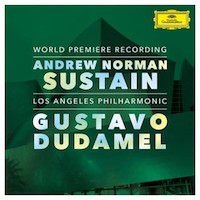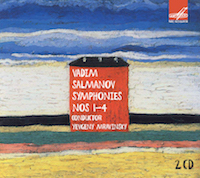Mostly Symphonies 36.
|
Grant Chu Covell [January 2020.]
Fritz VOLBACH: Es waren zwei Königskinder, Op. 21 (1900); Symphony in B minor, Op. 33 (1908). Sinfonieorchester Münster, Golo Berg (cond.). cpo 777 886–2 (1 CD) (http://www.cpo.de/). A recent conversation probing the question, “Who wrote the most accomplished First Symphony,” settled first upon Mahler, but then, after some discussion, arrived at Nielsen. Volbach (1861-1940) could be on the shortlist. This German composer was trained in Cologne and Berlin, and later held conducting duties in Tübingen and Münster at the 20th-century’s start. Volbach’s fairly traditional four-movement symphony places the scherzo second. A vigorous opening movement offers genial drama, recalling Dvořák’s late symphonic poems. The brief Scherzo startles with unfathomable harmonies in duple meter contradicting a bucolic trio. These four minutes would be the B-minor symphony’s most avant-garde moments. A soaring Adagio suggests an acquaintance with similar movements by Mahler, Bruckner and Elgar. Volbach and Elgar were in fact friends: The Dream of Gerontius found its way in Germany with Volbach’s advocacy. At this point we would expect a rigorous finale. This release had opened with a symphonic poem (“Once upon a time there were two children of royal birth”) demonstrating gravitas and invention, including a solo for Ritter’s five-string viola alta, and so we know Volbach can handle counterpoint and original contours. However, the Finale’s corny jubilation greatly disappoints. The notes indicate a lurking religious program, but the delivery misaligns with the Symphony’s first three movements. Buoyantly delivered by the orchestra Volbach himself founded in 1919, the Symphony’s unexpected Scherzo is worth the price of admission.
Andrew NORMAN: Sustain (2018). Los Angeles Philharmonic, Gustavo Dudamel (cond.). DG 0289 483 7608 7 (download) (http://www.deutschegrammophon.com/). Norman’s music has been intentionally sidelined on these pages. Prior works, such as Play (2013), suffer from excessive notes and negligible development. Sustain may represent a new plateau: Sloppiness is replaced with purposeful elaboration, interesting repeated ideas, and occasional astonishing flashes. Apart from framing filigree provided by two pianos tuned a quarter-tone apart, Sustain arranges overlapping shapes that repeat at different speeds. Strings and winds argue against each other while active percussion emphasizes changing tempos. We hear echoes of Sibelius and John Luther Adams as held notes coalesce into chords. I am guardedly surprised that Norman created this because, frankly, I have found other pieces to be amateurish. This fine recording takes 33 minutes. Norman’s publisher indicates a 40-minute duration implying Dudamel applied insights into pacing.
Gustav MAHLER: Titan: Eine Tondichtung in Symphonieform (Symphony No. 1) (1893-94; ed. 2019) Les Siècles, François-Xavier Roth (cond.). HMM 905299 (1 CD) (http://www.harmoniamundi.com/). Mahler’s First overflows with idealism and energy no matter which version. Here we have its second incarnation (1893-94), with the Blumine second movement, realizing a fresh 2019 critical edition. The familiar 1896 version increases the winds and uses more intense instrumentation (harmonics for quiet textures, instrumental doublings to be sure lines are heard). Perhaps this earlier orchestration is naïve and less emphatic. I welcome hearing the trivial Blumine which may have been dropped because it breaks the flow, or because it reminded Mahler of a romance gone astray. Indeed, the following Scherzo is performed vigorously. The booklet includes Mahler’s original (1893) movement titles: “Full sail ahead” for the Scherzo, “Failed!” for the funeral march, and “From Hell” for the Finale. In the beefier 1896 version, I wish Mahler had pruned and edited the expositions in the first and last movements, however, here we get to hear thinner period instrument timbres. In the notes Roth points out how the orchestra used 19th-century German and Austrian winds which are darker hued than the orchestra’s customary French winds.
“Music for Large Ensemble.” Tim BRADY: Désir: Concerto for Electric Guitar and Large Chamber Ensemble (2016-17)1. Eight Songs about: Symphony No. 7 (2016-17)2. Tim Brady1 (e-guit), Sarah Albu2 (sop), Vincent Ranallo2 (bar), Bradyworks Large Ensemble1,2, Cristian Gort1, Tim Brady2 (cond.). Starkland ST-230 (1 CD) (http://www.starkland.com/). Brady’s Symphony No. 7 is about the first performance of another Seventh, Shostakovich’s Seventh which was premiered August 9, 1942, in Leningrad, during the siege. Soprano and baritone speak and sing an English language text by Douglas Smith which chronicles the premiere from different perspectives: Stalin, Shostakovich’s wife Nina Varzar, residents of Leningrad, a soldier, the orchestra’s conductor Karl Eliasberg, and orchestral musicians. The music interests more than its description, and Brady keeps Shostakovich’s music at bay. Is Brady’s work about survival, or war, or is it a reminder that what we hear today as Shostakovich’s heroic Seventh is not the propaganda heard back in 1942? Brady’s Seventh deftly sustains our interest. The program begins with a concerto for electric guitar. Désir fills the traditional fast-slow-fast concerto form with predominantly tonal, sometimes minimal touches. Brady takes on the solo part, balancing well against the ensemble.
Vadim SALMANOV: Symphony No. 1 in D minor (1952); Symphony No. 2 in G major (1959); Symphony No. 3 in A minor (1963); Symphony No. 4 in B minor (1976). The Academic Symphony Orchestra of the Leningrad Philharmonic Society, Yevgeny Mravinsky (cond.). Melodiya MEL CD 10 02119 (2 CDs) (http://www.melody.su/). Salmanov’s four symphonies stride down a path somewhere between Shostakovich and Myaskovsky, although closer to the former’s angularity than the latter’s swirling late-Soviet Romanticism. Salmanov’s expositions tend to lead with a tart lyric line which the notes attribute to an incorporation of Czech or Slovakian folk tunes. Melodies with raised fourths are commonplace, and there are gestures that would not be out of place in Martinů. The notes suggest there are programs in each or that they are extended symphonic poems. The four-movement No. 2, dedicated to Shostakovich, wears movement titles depicting a pastoral landscape: “Song of Forest,” “Call of Nature,” “At Sunset,” and “…And the Forest Sings.” The slower, contemplative outer movements are materially connected, and the central pair, an Andante followed by an Allegro molto e feroce, could be an interruption. “At Sunset” is unexpectedly menacing, perhaps we are in a city gazing upon distant countryside, or perhaps there is some other metaphor. Despite the anchoring key of A minor, No. 3 explores atonality. It could pass for something Eastern European, perhaps even American. This symphony is dedicated in memory of the composer’s mother, but like No. 2, movement titles and dedications may dissemble. The Andante slow-movement’s simple melody echoes No. 2’s “forest” theme. There is nothing peaceful here, from the initial somber Mesto through to the concluding Andante non troppo. The First and Fourth are dedicated to Mravinsky, who leads all four of these live radio broadcast recordings (from 1957, ‘60, ‘64 and ‘77). The first three symphonies are flat mono recordings which instantaneously historicizes these Soviet works (they also each end with applause unlike the stereo No. 4). Nos. 1 and 4 are both three movements. The notes present No. 1 as a war symphony, chronicling survival in the face of battle and deprivation. The First may sound closest to Shostakovich with foursquare rhythms and pacing, but it also holds neoclassical touches in the central Andante which could be minor-mode Haydn. No. 4 continues No. 3’s restlessness, however, clothed with lyrical lines and tangy chorales referencing No. 1. The central Marciale surprises with ironic tonality; piccolo and trumpet lead us into a carnival that turns ominous.
[More Grant Chu Covell, Mostly Symphonies]
[Previous Article:
Two concerts]
[Next Article:
Used Bin Troll Tweets OO (Awards Edition)]
|




